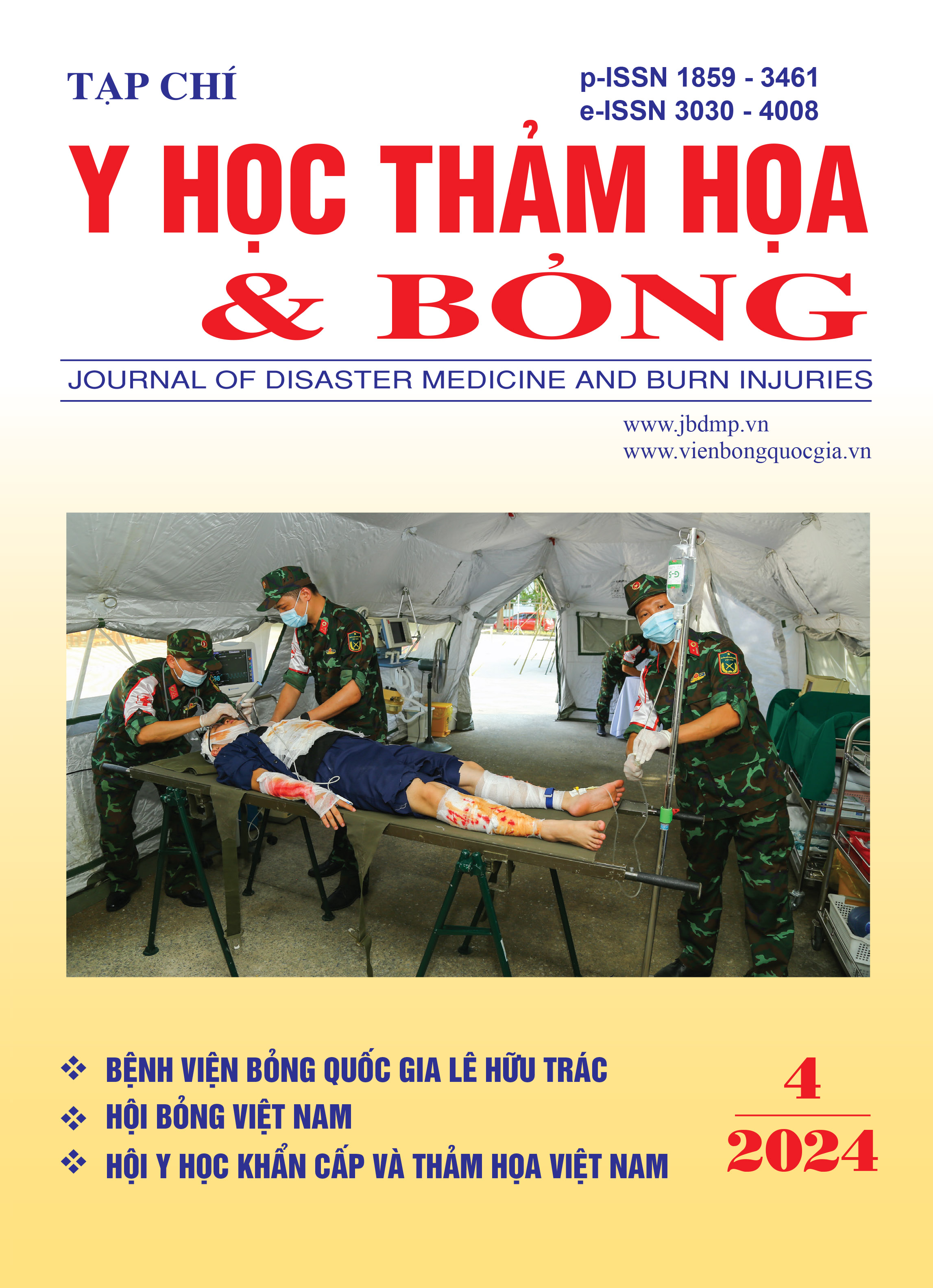Results of applying the deep inferior epigastric perforator “thin” pedicled flap for treatment of wrist defect postburn
Main Article Content
Abstract
Introduction: Distal skin flaps such as random abdominal flaps, Italian random skin flaps, groin flaps... are still effective methods for wrist reconstruction. However, there are some disadvantages when using these flaps: the thickness of the flap is bulky, and the time between the two stages is long (3 weeks).
Patients and Methods: The study used the deep inferior epigastric perforator “thin” pedicled flap to resurface the defect in the wrist and hand. The first surgery created an abdominal pedicle skin flap, clamping the pedicle of the flap is performed to decrease the time between two stages.
Results and discussion: The skin flap size ranges from (10 x 7)cm to (20 x 15)cm. Skin flap thickness before liposuction averaged 35.6 ± 4.27cm, and after liposuction averaged 10.9 ± 1.66cm. The time interval between the two surgeries was an average of 15.17 ± 4.71 days. Follow-up results at 3 months after surgery: Good: 9/11 (81.82%), average: 2/11 (18.18%). Follow-up results after 6 months: Good: 9/10 (90%), average: 1/10 (10%).
Conclusion: The modified “thin” deep inferior epigastric artery perforator pedicled skin flap is a useful option for the reconstruction of burn wounds with exposed tendons in the wrist area.
Article Details
Keywords
burn injury in the wrist area, distal pedicle skin flap, deep inferior epigastric artery perforator flap, iposuction
References
2. Gutwein, L. G., Merrell, G. A., & Knox, K. R. (2015). Paraumbilical perforator flap for soft tissue reconstruction of the forearm. The Journal of Hand Surgery, 40(3), 586-592.
3. Ohjimi H., Taniguchi Y., Kawano K.. et al (2000). A comparison of thinning and conventional free-flap transfers to the lower extremity. Plastic and reconstructive surgery.105 (2): 558-566.
4. Phạm Trần Xuân Anh (2012). Kết quả điều trị khuyết mô mềm vùng cổ bàn tay bằng vạt da cân. Hội nghị Ngoại khoa toàn quốc lần thứ XIV, Hội Ngoại khoa Việt Nam, Ngoại khoa số (1), (2), (3):379-384.
5. Kimura N., Satoh K. and Hosaka Y. (2003). Microdissected Thin Perforator Flaps:: 46 Cases. Plastic and reconstructive surgery.112 (7): 1875-1885.
6. Nguyễn Trọng Luyện (2018). Nghiên cứu giải phẫu và ứng dụng vạt da cuống hẹp nhánh xuyên động mạch gian sườn trong điều trị bỏng sâu và di chứng bỏng chi trên, Luận án Tiến sĩ Y học, Học viện Quân y, Hà Nội.
7. Askouni E. P., Topping A., Ball S.. et al (2012). Outcomes of anterolateral thigh free flap thinning using liposuction following lower limb trauma. Journal of plastic, reconstructive & aesthetic surgery.65 (4): 474-481
8. Wang, J., Wang, M., Xu, Y., Guo, Y., & Cui, L. (2017). Paraumbilical Perforator Flap: A Good Choice for the Repair of the Deep Soft Tissue Defects in the Hand and Forearm. J Gen Pract (Los Angel), 5(333), 2.
9. Shukla, L., Taylor, G. I., & Shayan, R. (2013). The pedicled inferior paraumbilical perforator (I-PUP) flap for a volar wrist defect: a reconstructive solution across the ages. Journal of Plastic, Reconstructive & Aesthetic Surgery, 66(11), 1613-1615.
10. Ettefagh MH, Naraghi M, Towhidkhah F. Position control of a flexible joint via explicit model predictive control: An experimental implementation. Emer Sci J. 2019;3.


